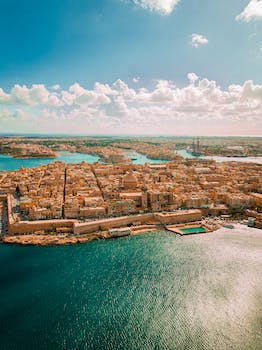

-
Table of Contents
Unlocking the potential of our oceans for a sustainable future.
Introduction
Ocean infrastructure refers to man-made structures and facilities built in or on the ocean to support various activities and industries. These structures can include offshore platforms, ports, harbors, underwater pipelines, and even artificial islands. While the development of ocean infrastructure may have its challenges, it also offers numerous benefits that contribute to economic growth, environmental conservation, and scientific advancements. In this introduction, we will explore some of the key advantages of ocean infrastructure.
Economic Advantages of Ocean Infrastructure
Ocean infrastructure refers to the various man-made structures and facilities that are built in and around the ocean to support economic activities. These structures include ports, harbors, offshore platforms, and underwater pipelines, among others. While the primary purpose of ocean infrastructure is to facilitate maritime trade and transportation, it also brings about several economic advantages.
One of the key economic benefits of ocean infrastructure is the boost it provides to international trade. Ports and harbors serve as gateways for goods to enter and exit a country, facilitating the movement of goods between different regions of the world. By providing docking facilities for cargo ships, these structures enable the efficient loading and unloading of goods, reducing turnaround times and increasing the overall productivity of trade. This, in turn, leads to increased economic activity and job creation.
Furthermore, ocean infrastructure plays a crucial role in supporting the growth of the offshore oil and gas industry. Offshore platforms are used for drilling and extracting oil and gas reserves located beneath the ocean floor. These platforms provide a stable base for drilling operations and house the necessary equipment and personnel. The development of offshore oil and gas fields not only contributes to energy security but also generates significant revenue through the extraction and sale of these resources. This revenue can be used to fund various social and economic development projects, benefiting the overall economy.
In addition to facilitating trade and supporting the energy sector, ocean infrastructure also promotes tourism and recreational activities. Coastal areas with well-developed infrastructure, such as marinas and beach resorts, attract tourists from around the world. These tourists contribute to the local economy by spending money on accommodation, food, and leisure activities. Moreover, the presence of recreational facilities, such as diving centers and water sports clubs, creates employment opportunities for local communities. The revenue generated from tourism and recreational activities can be reinvested in the development of the region, further stimulating economic growth.
Another economic advantage of ocean infrastructure is its role in supporting the fishing industry. Fishing ports and processing facilities provide the necessary infrastructure for the storage, processing, and distribution of fish and seafood products. These facilities enable fishermen to bring their catch ashore, where it can be processed, packaged, and transported to markets. The fishing industry not only provides employment opportunities for fishermen but also supports related industries, such as fish processing, packaging, and transportation. This industry contributes to the local economy and helps meet the demand for seafood both domestically and internationally.
In conclusion, ocean infrastructure brings about several economic advantages. It facilitates international trade, supports the offshore oil and gas industry, promotes tourism and recreational activities, and supports the fishing industry. These economic benefits contribute to job creation, revenue generation, and overall economic growth. Therefore, investing in the development and maintenance of ocean infrastructure is crucial for countries seeking to harness the economic potential of their coastal areas.
Environmental Benefits of Ocean Infrastructure

Ocean infrastructure refers to man-made structures that are built in or near the ocean to serve various purposes. While the primary goal of ocean infrastructure is often to support economic activities such as shipping, fishing, and offshore energy production, it also offers several environmental benefits. In this section, we will explore some of these benefits and highlight the importance of ocean infrastructure in promoting a healthy marine ecosystem.
One of the key environmental benefits of ocean infrastructure is the creation of artificial reefs. These structures, such as sunken ships, concrete blocks, and oil rigs, provide a substrate for the growth of marine organisms. Over time, these structures become home to a diverse array of marine life, including corals, sponges, and fish. Artificial reefs not only enhance biodiversity but also serve as important habitats for endangered species. By providing shelter and food sources, they contribute to the overall health and resilience of the marine ecosystem.
In addition to supporting marine life, ocean infrastructure can also help protect coastal areas from erosion. For example, breakwaters and seawalls are often constructed to reduce the impact of waves and currents on shorelines. These structures act as barriers, absorbing and dissipating the energy of incoming waves, thereby preventing erosion and preserving beaches. By stabilizing coastal areas, ocean infrastructure plays a crucial role in protecting valuable habitats, such as mangroves and salt marshes, which are vital for the survival of many species.
Furthermore, ocean infrastructure can contribute to the restoration of degraded habitats. For instance, in areas where seagrass beds have been damaged or lost, artificial seagrass structures can be deployed to encourage the recovery of these important ecosystems. These structures mimic the natural structure of seagrass beds and provide a substrate for seagrass colonization. As seagrass beds are known for their ability to sequester carbon dioxide and provide nursery grounds for juvenile fish, their restoration through ocean infrastructure can have significant positive impacts on both the environment and local communities.
Another environmental benefit of ocean infrastructure is the promotion of sustainable aquaculture practices. Offshore fish farms, for example, can be designed to minimize the environmental impacts associated with traditional coastal aquaculture. By locating fish farms further offshore, the risk of pollution and disease transmission to wild populations is reduced. Additionally, the use of advanced technologies, such as closed containment systems, can further mitigate the negative effects of fish farming on water quality and biodiversity. Ocean infrastructure thus enables the expansion of sustainable aquaculture, which can help meet the growing global demand for seafood while minimizing its ecological footprint.
In conclusion, ocean infrastructure offers several environmental benefits that should not be overlooked. From the creation of artificial reefs to the protection of coastal areas and the restoration of degraded habitats, these man-made structures play a crucial role in promoting a healthy marine ecosystem. Furthermore, ocean infrastructure can support sustainable aquaculture practices, ensuring the availability of seafood while minimizing its environmental impact. As we continue to explore and utilize the ocean's resources, it is essential to recognize and harness the potential of ocean infrastructure in achieving a balance between economic development and environmental conservation.
Social Impacts of Ocean Infrastructure
Ocean infrastructure refers to the various man-made structures that are built in and around the ocean to support a wide range of activities. While the economic benefits of ocean infrastructure are well-known, its social impacts are often overlooked. In this section, we will explore some of the key social benefits that ocean infrastructure brings to communities and societies.
One of the most significant social impacts of ocean infrastructure is the creation of employment opportunities. The construction and maintenance of ocean infrastructure projects require a skilled workforce, which in turn leads to job creation. This is particularly important for coastal communities that may have limited employment options. By providing jobs, ocean infrastructure projects contribute to the economic well-being of these communities and help reduce unemployment rates.
In addition to job creation, ocean infrastructure also plays a crucial role in improving access to essential services. For example, the construction of ports and harbors enables easier transportation of goods, which is vital for trade and commerce. This, in turn, leads to increased availability of goods and services in coastal areas, benefiting both residents and businesses. Furthermore, ocean infrastructure such as offshore wind farms can provide clean and renewable energy to nearby communities, reducing their dependence on fossil fuels and contributing to a more sustainable future.
Another social benefit of ocean infrastructure is its role in disaster management and mitigation. Coastal areas are often prone to natural disasters such as hurricanes and tsunamis. Well-designed ocean infrastructure, such as seawalls and breakwaters, can help protect coastal communities from the destructive forces of these events. By providing a physical barrier, these structures can reduce the impact of storms and prevent or minimize damage to homes, businesses, and infrastructure. This not only saves lives but also helps communities recover more quickly after a disaster.
Furthermore, ocean infrastructure can also have positive social impacts by promoting tourism and recreational activities. Coastal areas with well-developed infrastructure, such as marinas and beachfront promenades, attract tourists and visitors. This, in turn, boosts local economies and creates opportunities for small businesses such as hotels, restaurants, and souvenir shops. Additionally, recreational activities such as boating, fishing, and diving are made more accessible and enjoyable through the presence of ocean infrastructure. These activities not only provide entertainment and relaxation for residents and visitors but also contribute to the overall well-being and quality of life in coastal communities.
Lastly, ocean infrastructure can also have cultural and educational benefits. For example, the construction of underwater museums and artificial reefs not only provides habitats for marine life but also creates unique opportunities for divers and researchers to explore and study underwater ecosystems. These initiatives not only promote environmental awareness but also help preserve and celebrate local culture and history. By showcasing artifacts and promoting educational programs, ocean infrastructure can contribute to the preservation and transmission of cultural heritage.
In conclusion, ocean infrastructure brings a wide range of social benefits to communities and societies. From job creation and improved access to essential services to disaster management and mitigation, tourism promotion, and cultural preservation, the social impacts of ocean infrastructure are significant and far-reaching. It is important to recognize and appreciate these benefits as we continue to develop and utilize ocean resources in a sustainable and responsible manner.
Q&A
1. What are the benefits of ocean infrastructure?
Ocean infrastructure provides numerous benefits, including enabling efficient transportation of goods, supporting offshore energy production, facilitating scientific research and exploration, and promoting tourism and recreational activities.
2. How does ocean infrastructure contribute to economic growth?
Ocean infrastructure plays a crucial role in supporting maritime trade, which is essential for global economic growth. It enables the transportation of goods, enhances connectivity between countries, and supports industries such as fishing, offshore oil and gas extraction, and tourism, all of which contribute to economic development.
3. What environmental benefits does ocean infrastructure offer?
Ocean infrastructure can have positive environmental impacts by providing artificial reefs that enhance marine biodiversity and serve as habitats for various species. Additionally, it can support renewable energy generation, such as offshore wind farms, reducing reliance on fossil fuels and mitigating climate change.
Conclusion
In conclusion, ocean infrastructure offers numerous benefits. It enables the exploration and utilization of marine resources, supports various industries such as shipping and offshore energy, and facilitates scientific research and monitoring of the ocean. Additionally, ocean infrastructure plays a crucial role in disaster response and mitigation efforts, as well as in the development of sustainable coastal communities. Overall, investing in ocean infrastructure can contribute to economic growth, environmental protection, and improved quality of life for coastal populations.












